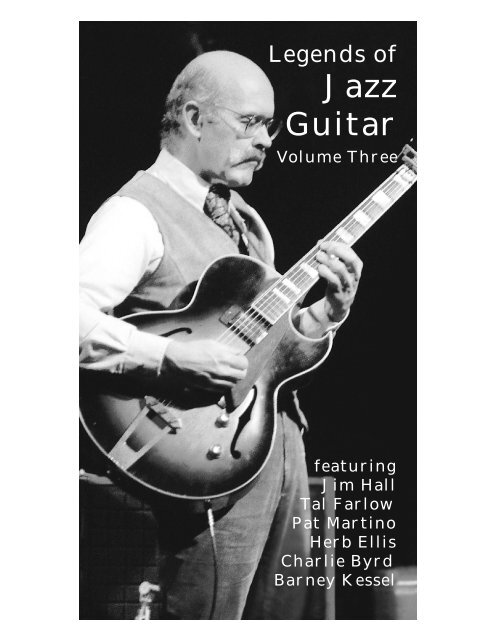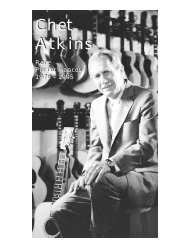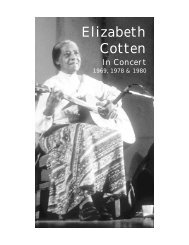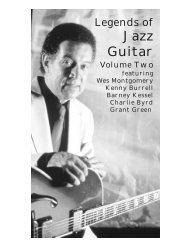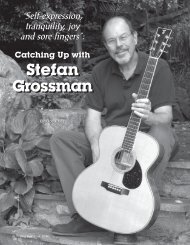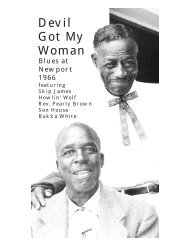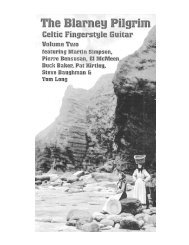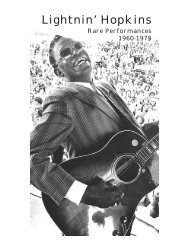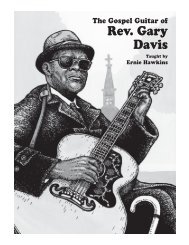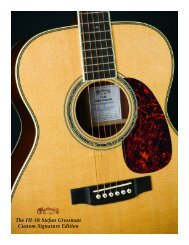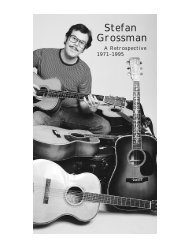Legends Of Jazz Guitar - Stefan Grossman's Guitar Workshop
Legends Of Jazz Guitar - Stefan Grossman's Guitar Workshop
Legends Of Jazz Guitar - Stefan Grossman's Guitar Workshop
Create successful ePaper yourself
Turn your PDF publications into a flip-book with our unique Google optimized e-Paper software.
<strong>Legends</strong> of<br />
<strong>Jazz</strong><br />
<strong>Guitar</strong><br />
Volume Three<br />
featuring<br />
Jim Hall<br />
Tal Farlow<br />
Pat Martino<br />
Herb Ellis<br />
Charlie Byrd<br />
Barney Kessel
LEGENDS OF JAZZ GUITAR<br />
VOLUME THREE<br />
by Mark Humphrey<br />
Funny how unlikely couples get together. Take, for<br />
instance, the guitar and jazz. The guitar, rooted somewhere<br />
in Moorish Spain and Americanized as a ladies’<br />
parlor instrument or a cowboy’s companion, is not by<br />
its acoustic nature a convincing surrogate horn. <strong>Jazz</strong>,<br />
rooted in African polyrhythms and nurtured in Southern<br />
brass bands, is seemingly too raucously aggressive<br />
to keep company with a delicately-strung wooden box.<br />
But leave it to imaginative musicians and instrument<br />
makers to find ways around such contradictions. If the<br />
guitar was ever an anomaly in jazz it ceased to be long<br />
ago. Can you even imagine the idiom without the guitar’s<br />
voluble presence? A key player in the band would be<br />
missing.<br />
The six men seen and heard in this video are among<br />
the most exemplary band members to choose the guitar<br />
as their means of expression. The initial inspiration<br />
for most of them was Charlie Christian, who blazed trails<br />
jazz guitarists still tred a half century later. Christian<br />
swung in the direction of bop, and his disciples (foremost<br />
among whom are seen here) boldly carried the<br />
guitar into that next phase of jazz. Aside from their fervor<br />
for the potential of the guitar in the evolution of jazz,<br />
many of these artists have similar backgrounds: Southern<br />
or Southwestern, and of roughly the same generation.<br />
But their individuality is abundantly clear in performances<br />
ranging from meditative ballads to speedof-sound<br />
boppers. Underlying it all is an exhilarating<br />
sense of triumph over that apparent oxymoron, jazz<br />
guitar. Having proven that the guitar is indeed a first<br />
rate medium for jazz expression, these artists confidently<br />
address other contradictions, ones involving evolution<br />
within a well-grounded tradition. They’re serious about<br />
their business, but you can see them having fun with it,<br />
too.<br />
2
3<br />
Photo by Tom Copi
JIM HALL<br />
This collection of performances opens with a George<br />
Bassman – Ned Washington ballad which was the theme<br />
of the Tommy Dorsey Orchestra. Jim Hall, who played<br />
“I’m Getting Sentimental Over You” for the BBC in 1964,<br />
told <strong>Guitar</strong> Player five years later: “I enjoy ballads, standards.<br />
By standards, I mean I enjoy things with chord<br />
progressions more than ‘open free’ music. I also like<br />
medium swing tempos.”<br />
A year older than 1932’s “I’m Getting Sentimental<br />
Over You,” Hall says he was “brought up in the Baptist<br />
Midwestern environment of Cleveland, Ohio.” He started<br />
playing guitar at age ten; like most jazz guitarists of his<br />
generation, Hall had a ‘Damascus road’ experience with<br />
Charlie Christian. “The first time I heard him I was 13<br />
years old,” he told down beat’s Mitchell Seidel, “and it<br />
changed my life.” The performance that bowled Hall over<br />
was “Grand Slam.” Half a century later, Hall says<br />
Christian’s style “sounds old and brand-new at the same<br />
time.”<br />
Though determined to play jazz guitar, Hall says<br />
“Baptist guilt” drove him to earn a Bachelor of Music<br />
degree from the Cleveland Institute of Music. “I was actually<br />
being primed to become a music teacher or composer,”<br />
Hall told down beat’s Bill Milkowski, but the prospect<br />
of an exclusively academic life prompted him to<br />
drop out before attaining his master’s degree and head<br />
for Los Angeles. Still, Hall deems his formal training a<br />
plus: “I could read music fairly well for a guitar player,”<br />
he says (he wrote a string quartet as his thesis). “When<br />
I was in music school,” Hall told <strong>Guitar</strong> Player’s Jim<br />
Ferguson, “I heard everything from Gregorian chant to<br />
12-tone and electronic music, which was pretty new<br />
back then. It opened my view of what music could be.”<br />
Hall arrived in Los Angeles in 1955 and simultaneously<br />
studied classical guitar with Vicente Lopez while<br />
hanging out on the jazz scene. If Hall was initially unsure<br />
of his direction, a work call from drummer Chico<br />
Hamilton changed that. Still, he insists his classical training<br />
left its mark. “I keep my strings lighter than most,”<br />
4
Photo by Tom Copi<br />
Hall told Seidel.<br />
“Part of that was trying<br />
to get a classical<br />
guitar sound out of<br />
this instrument... My<br />
sound is a combination<br />
of Charlie Christian<br />
and classical<br />
guitar.”<br />
Hall’s jazz baptism<br />
with Hamilton<br />
was followed by a<br />
challenging stint<br />
with saxophonist/<br />
clarinetist Jimmy<br />
Guiffre (“It cost me<br />
a few hairs, but it<br />
was worth it,” he<br />
says) and work accompanying<br />
the supreme<br />
chanteuse of jazz, Ella Fitzgerald. “Playing with<br />
singers,” Hall told Norman Mongan, “gave me a sense<br />
of space, a way of placing notes in relation to the lyrics,<br />
which is quite different from accompanying another<br />
instrument.”The way Hall ‘breathes’ is heard to good<br />
effect in both “I’m Getting Sentimental Over You” and<br />
“My Funny Valentine.”<br />
By the late 1950s, Hall’s services were in demand<br />
by such legends as tenor saxophonist Ben Webster and<br />
pianist Bill Evans. Hall considers his 1961 stint with tenor<br />
saxophonist Sonny Rollins an exhilarating career highlight:<br />
“He inspired me more than any other musician I<br />
had played with up to then,” says Hall. Rollins is the<br />
composer of “Valse Hot,” which Hall performed for the<br />
BBC in 1964 as a member of the Art Farmer Quartet.<br />
With Farmer’s distinctive fluegelhorn to the fore, Hall,<br />
bassist Steve Swallow and drummer Pete La Roca made<br />
a striking ensemble. (Swallow and La Roca accompanied<br />
Hall on “I’m Getting Sentimental Over You.”) His<br />
instrument in this group was a single pickup Gibson ES-<br />
175 which had previously belonged to Howard Roberts.<br />
5
“What I do best,” Hall has said, “is react to other<br />
musicians.” In 1965; he realized that drink was slowing<br />
his reactions, so he retired, got sober, and spent the<br />
next three and-a-half years in the house band of the<br />
Merv Griffin Show. “That always sounds like a confession<br />
when I mention it now,” Hall quips of his television<br />
job. When the Griffin show moved from New York to<br />
California, Hall didn’t. He began performing with bassist<br />
Ron Carter and gradually worked his way back into<br />
doing what he loves most, playing jazz. Twenty two years<br />
after the BBC performances, we find Hall in Denmark<br />
for a rendition of the Rodgers and Hart classic, “My<br />
Funny Valentine” from the 1937 musical Babes in Arms.<br />
Joining him is the extraordinary French pianist Michel<br />
Petrucciani, whose height (less than three feet) is no<br />
measure of his talent. Hall toured Europe with<br />
Petrucciani in 1986, and told down beat’s Bill Milkowski:<br />
“Michel’s such a wonderful player and makes it easy<br />
because he listens so hard and reacts so fast. To me,<br />
that’s really the gist of playing together. It all boils down<br />
to whether or not the guys listen to one another, and<br />
Michel does that very well.”<br />
Hall has been called “the most romantic and subtle<br />
of the modern guitarists,” but he has also challenged<br />
himself in recent years by collaborating with such<br />
progressives as Bill Frisell and John Abercrombie.<br />
“These younger guys always inspire me, says Hall,<br />
whose first solo guitar album (Dedications & Inspirations,<br />
Telarc) appeared in 1994. “I’m sure that it’s never over,”<br />
Hall told Mitchell Seidel, “at least it certainly isn’t for<br />
me. I practiced today already, and if I don’t, it’s like<br />
somebody stepped on my hand. That’s another one of<br />
the beauties of it-that it goes on forever.”<br />
6
BARNEY KESSEL, HERB ELLIS,<br />
AND CHARLIE BYRD<br />
“THE GREAT GUITARS”<br />
Photo by Tom Copi<br />
In 1973, Australian jazz promoter Kim Bonythan<br />
brought Barney Kessel, Herb Ellis, and Charlie Byrd to<br />
Australia and New Zealand for a nine-concert tour. “The<br />
promoter wanted Herb and me to play the first part of<br />
the concert, Charlie and his group the second, and all<br />
of us together for the finale,” Kessel told <strong>Guitar</strong> Player’s<br />
Robert Yelin. “It was a lot of fun playing with them,”<br />
Byrd told Frets editor Jim Hatlo, “and the audiences<br />
really responded to the way we were enjoying ourselves.<br />
So we decided to keep it going.” The tour launched The<br />
Great <strong>Guitar</strong>s, a group which gave new meaning to the<br />
term ‘power trio.’ Drawing on a combined 90 years of<br />
professional experience, The Great <strong>Guitar</strong>s featured inspired<br />
dialogues among three of jazz guitar’s most fluent<br />
voices.<br />
The most outspoken of these voices is Barney<br />
Kessel. The son of an immigrant Russian Jewish<br />
bootmaker, Kessel was born in Muskogee, Oklahoma<br />
in 1923. He grew up hearing cowboy songs like “Rye<br />
Whiskey” and old hymns strummed on guitar. When he<br />
was 12, he bought a guitar complete with strings, a pick,<br />
and an instruction book for one dollar. Tutored by Charlie<br />
7
Keoube in a Federal Music Project of the WPA, Kessel<br />
received a three-month ‘crash course’ in guitar and<br />
music theory in 1935. Two years later, Kessel was playing<br />
well enough to join an otherwise black jazz band. It<br />
was there he first heard the name Charlie Christian.<br />
By the time he actually met Christian in 1940, Kessel<br />
had listened intently to that pioneer’s work with Benny<br />
Goodman and thoroughly absorbed Christian’s style. But<br />
the experience of jamming with his idol jarred him:<br />
“When I began improvising with Charlie Christian,”<br />
Kessel recalled, he had to ask himself, “What am I going<br />
to play?” Kessel realized he would have to find his<br />
own musical voice rather than merely mirror Christian’s.<br />
Experiences in a varied settings on the road (with<br />
the bands of Chico Marx, Artie Shaw and Charlie Barnet)<br />
and in the studio (with the legendary likes of Lester<br />
Young and Charlie Parker) went a long way toward earning<br />
Kessel his own unique identity, one which bridged<br />
the sounds of swing and bebop. In 1952, he joined bassist<br />
Ray Brown and pianist Oscar Peterson in an influential<br />
trio which spotlighted Kessel’s talents. But family<br />
concerns prompted Kessel to leave Peterson’s trio in<br />
1953. Before departing, he recommended Herb Ellis for<br />
the job.<br />
“We met 30 years ago at the Taft Hotel in New York<br />
City,” Ellis told Robert Yelin in 1974. “Barney had some<br />
trouble with his guitar, so he came to borrow mine. He<br />
was working with Artie Shaw then, and I was off from<br />
the Jimmy Dorsey band that night. From that first meeting<br />
we jammed, and we’ve been jamming ever since.”<br />
Beyond common musical passions, Ellis and Kessel<br />
shared similar beginnings in Southwestern small towns.<br />
For Ellis, it was Farmville, Texas, where he was born in<br />
1921. “My mother tells me I always played the blues,”<br />
Ellis recalls. His interest in jazz blossomed at North Texas<br />
State College, where Ellis majored in music and eagerly<br />
explored Charlie Christian’s recordings with Benny<br />
Goodman’s Sextet. Both Ellis and Kessel cite the same<br />
formative influences: Christian, tenor saxophonist Lester<br />
Young and alto saxophonist Charlie Parker.<br />
8
Kansas City was still a jazz Mecca when Ellis joined<br />
the Glen Gray’s Casa Loma Orchestra in the early 1940s.<br />
Praised in down beat and Metronome, Ellis then moved<br />
up to Jimmy Dorsey’s Orchestra. After World War II,<br />
piano, guitar and bass trios were all the rage and for<br />
awhile Ellis became a third of the Soft Winds. It was a<br />
calm before the storm of Oscar Peterson’s frenetic tempos<br />
in the trio which Ellis joined at Kessel's departure<br />
in 1953. “Herb Ellis,” Peterson wrote in Lp sleeve notes,<br />
“demonstrates...that he is not only a talented soloist,<br />
but that he has complete control of his instrument, along<br />
with a capacity for invention at all tempos...” Considering<br />
its source, that’s high praise indeed.<br />
Following five exhilarating years with Peterson and<br />
bassist Ray Brown, Ellis left to work as accompanist to<br />
Ella Fitzgerald for a year. There were occasional ventures<br />
as leader, such as the highly-regarded Verve album<br />
Nothing But the Blues, but Ellis spent much of the<br />
1960s and part of the 1970s in studio orchestras for a<br />
succession of television variety-talk shows, including<br />
the Merv Griffin Show. Ellis has characterized the studio<br />
musician’s life as “99% boredom, 1% absolute terror,”<br />
but admits he occasionally found inspiring material<br />
in that role.<br />
The outstanding feature of Ellis’ solos, writes jazz<br />
guitar historian Norman Mongan, is “an extraordinarily<br />
earthy quality...Ellis is unbeatable where swing and drive<br />
are concerned; his is a style of classic modern simplicity.”<br />
Ellis seemed to emphasize much the same point in<br />
discussing the empathy among Kessel, Byrd and himself<br />
with Robert Yelin: “We all have a mutual respect<br />
and great feeling for swing,” he said. “Without even talking<br />
about it among ourselves, swing is the basis for our<br />
wanting to play the guitar.”<br />
Charlie Byrd points to a slightly different impetus<br />
for taking up the instrument: “It was such a happy social<br />
occasion to play music at my house,” he recalled<br />
in a 1967 <strong>Guitar</strong> Player, “I guess I just wanted to be in<br />
on it.” The house was in Chuckatuck, Virginia, where<br />
Byrd was born in 1925. His father and uncle played fingerstyle<br />
guitar and his father ran a country store where<br />
9
“the black blues pickers came in on Saturday nights to<br />
play and drink a few beers,” Byrd recalled to Frets editor<br />
Jim Hatlo. He “learned by listening and absorbing.”<br />
But the radio brought him another musical world: “Fred<br />
Waring had a radio program that Les Paul was on during<br />
the late 1930s,” Byrd told Hatlo, and, of course, there<br />
were Benny Goodman’s groups. Theirs was the music<br />
Byrd aspired to play, even though he was happy in his<br />
teens to pick country and folk tunes on radio stations in<br />
Newport News and Suffolk. (At 14, Byrd acquired a<br />
Sears Silvertone electric guitar and amplifier, the first<br />
such contraption heard in Chuckatuck!)<br />
Like Kessel, Byrd got an early taste of the jazz life<br />
when, in his 14th summer, he played with a dance orchestra<br />
from William and Mary College at the resort town<br />
of Virginia Beach. The precocious Byrd enrolled in the<br />
Virginia Polytechnic Institute at age 16 and played in<br />
the school dance band. During World War II, Byrd played<br />
in the Special Forces band in Europe. He also got a<br />
chance to sit in with Django Reinhardt before shipping<br />
home. That meeting, Byrd asserts, “decided me on a<br />
career in jazz.”<br />
But he was sidetracked for a time by the lure of the<br />
classical guitar. Thanks in part to the G.I. Bill, Byrd studied<br />
with Sophocles Papas and, in 1954, made a pilgrimage<br />
to Siena, Italy to study with Segovia. The experience<br />
offered Byrd the humbling insight that “I wasn’t<br />
really going to be a significant classical guitar player,”<br />
he told Hatlo. “I realized that it might be a better idea<br />
for me to use all my life’s experience, in jazz and popular<br />
music as well, combining them with classical. So I<br />
started working out some jazz arrangements on classical<br />
guitar, and I thought, ‘Someone might be interested<br />
in recording these.”’ Savoy Records was interested, and<br />
in 1956 Byrd’s <strong>Jazz</strong> Recital album appeared.<br />
A 1961 State Department-sponsored ‘goodwill’ tour<br />
of Latin America brought Byrd into contact with the<br />
sounds of bossa nova. The following year his collaboration<br />
with tenor saxophonist Stan Getz, <strong>Jazz</strong> Samba, carried<br />
Brazil’s ‘new beat’ to the U.S. and became a surprise<br />
hit. (“Desifinado” made it to # 15 on the pop<br />
10
11<br />
Photo by Tom Copi
charts!) “I guess that got me typecast a little more than<br />
I would have liked,” Byrd admitted 20 years later, but it<br />
was a strong validation of his move to explore jazz on<br />
the classical guitar.<br />
Ironically, the ‘Great <strong>Guitar</strong>’ heard playing bossa<br />
nova on this collection isn’t Byrd but Kessel who shows<br />
his confidence in an idiom generally associated with fingerstyle<br />
guitarists and nylon-strung guitars. His medley<br />
of Luiz Bonfa’s “Manha de Carnaval” and “Samba de<br />
Orfeu” is taken from the evocative score for the 1960<br />
film, Black Orpheus. Accompanying Kessel on this 1969<br />
date in Denmark are Larry Ridley, bass, and Don<br />
Lamond, drums .<br />
A decade later, Kessel and Ellis teamed up on Iowa<br />
public television’s <strong>Jazz</strong> At The Maintenance Shop for a<br />
sassy sprint through George Gershwin’s “Oh! Lady Be<br />
Good,” a standard from the 1924 musical of the same<br />
name. The performance clearly reveals this duo’s roots<br />
in the Southwest, which gave the guitar world not only<br />
Charlie Christian but electric blues pioneer T–Bone<br />
Walker and Western Swing guitarist-arranger Eldon<br />
Shamblin of Bob Wills Texas Playboys. Kessel and Ellis<br />
seemingly return home here. Such performances inspired<br />
Norman Mongan to observe that Ellis’ “Southwestern<br />
twang...powerful attack and ‘stringy’ tonality<br />
make constant reference to his Texas origins.”<br />
Proving that great tunes often come from unlikely<br />
sources is the Bryson & Goldberg “Flintstones Theme”<br />
from the 1960s television cartoon series. Kessel and<br />
Ellis take a fiercely swinging romp through Bedrock accompanied<br />
by Joe Byrd, bass, and Wayne Phillips,<br />
drums. This performance is from a ‘duo’ spotlight of<br />
The Great <strong>Guitar</strong>s captured in Cork, Ireland in 1980.<br />
“What’s great about these concerts,” Ellis, the longtime<br />
television studio ace once said, “is that we’re playing<br />
duets for the public and getting paid for it.”<br />
Trios, too. Our collection’s finale features the full<br />
fleet of Great <strong>Guitar</strong>s in a medley tribute to three earlier<br />
extraordinary guitarists. It opens with “Nuages,” the<br />
most popular composition of Django Reinhardt (1910-<br />
1953), who recorded it at least 8 times. (“Nuages” made<br />
12
oth the French and British ‘hit parades.’) In a 1976<br />
<strong>Guitar</strong> Player tribute to Reinhardt, Kessel wrote: “He<br />
symbolizes the Gypsy spirit, the thing in everyone that<br />
wants to be free—to be an adult but not lose the childlike<br />
quality.”<br />
“Goin’ Out of My Head” was a 1964 hit for Little<br />
Anthony & the Imperials which became a 1966 Grammywinning<br />
vehicle for Wes Montgomery (1925-1968). It<br />
represents a phase of Montgomery’s career which<br />
brought him popular acclaim along with the disdain of<br />
some jazz fans who felt he had sold out. In a 1972 <strong>Guitar</strong><br />
Player discussion (‘Where Are the <strong>Jazz</strong> <strong>Guitar</strong> Lps?’),<br />
Kessel remarked: “I remember talking with Wes Montgomery<br />
when he was playing in a packed club. He wasn’t<br />
bitter, just realistic. He said, ‘See those people out there?<br />
They didn’t come to hear me, they came to see me play<br />
one, two or three of my hit records, because when I decide<br />
to do a tune of mine or Coltrane’s ‘Giant Steps’<br />
instead of ‘Goin’ Out My Head’ they get bored and start<br />
talking.’” Success for a jazz musician can be a mixed<br />
blessing.<br />
The medley closes with the Benny Goodman-Lionel<br />
Hampton composition “Flying Home,” long the theme<br />
of the Lionel Hampton Orchestra and, in its early days,<br />
a showcase for Charlie Christian (1916-1942), without<br />
whom most of the music on this video is unthinkable.<br />
The trio of Byrd (on an Ovation acoustic–electric),<br />
Kessel and Ellis (both playing Gibsons) gave this exhilarating<br />
1980 performance in Cork, Ireland in the company<br />
of bassist Joe Byrd and drummer Wayne Phillips.<br />
In a 1974 <strong>Guitar</strong> Player interview, Ellis gave away<br />
part of The Great <strong>Guitar</strong>s’ game. “What’s particularly<br />
good about a trio,” Ellis explained to Robert Yelin, “is<br />
that the soloist can concentrate completely on his<br />
chorus...the other two guys will come in to take over<br />
the ensemble part while the soloist is thinking only about<br />
his solo.” Byrd summed up The Great <strong>Guitar</strong>s experience<br />
this way: “We have a great time,” he said, “and we<br />
enjoy each other’s company...We just love to go out there<br />
and swing for them. We couldn’t swing the way we do if<br />
these concerts didn’t make us happy.”<br />
13
Photo by Tom Copi<br />
TAL FARLOW<br />
The stunning<br />
velocity and facility<br />
with which Tal Farlow,<br />
pianist Tommy Flanagan<br />
and bassist Red<br />
Mitchell blaze through<br />
“Fascinating Rhythm”<br />
(a Gershwin tune from<br />
the 1924 musical, Oh!<br />
Lady Be Good) in<br />
Lorenzo De<strong>Stefan</strong>o’s<br />
1981 documentary,<br />
Talmadge Farlow, is a<br />
jaw-dropping study in<br />
abandon earned by<br />
years of woodshedding.<br />
Farlow has only<br />
reluctantly left his<br />
woodshed in recent<br />
decades, and the rarity<br />
of his public appearances<br />
has only enhanced his deserved reputation<br />
as a jazz genius.<br />
Jim Hall has called Farlow “the most complete musician<br />
I know on guitar,” and he’s not alone in that opinion.<br />
Farlow turned up the heat several notches on bopera<br />
guitarists by his innovative work in the Red Norvo<br />
Trio in the 1950s. “Farlow took the message of hard<br />
bop and translated it for the guitar,” writes Norman<br />
Mongan in The History of the <strong>Guitar</strong> in <strong>Jazz</strong>. “Always<br />
inspired, he let ideas flow from under his fingers and<br />
creates a sound more akin to that of a wind instrument<br />
than a guitar.” Blowing at tempos few guitarists dare<br />
match, it wasn’t only for his large hands that Farlow<br />
earned the nickname the Octopus: he was seemingly<br />
everywhere on the fingerboard at once.<br />
Talmadge Holt Farlow was born in Greensboro,<br />
North Carolina in 1921. It’s often been said that he didn’t<br />
start playing till his early twenties, but that isn’t exactly<br />
14
true. “I could already play the guitar a little bit,” Farlow<br />
told down beat reporter Lee Jeske, “but the guitar was,<br />
in most cases, part of a hillbilly band—you know, with<br />
three chords.” The guitarist who made him think, “Now<br />
I’ve got an instrument here that can conceivably move<br />
out front” was, naturally, Charlie Christian. “Christian<br />
was the one who got me moving,” Farlow told Burt Korall<br />
(down beat February 22, 1979). “I bought all the<br />
Goodman–Christian recordings and memorized Charlie’s<br />
choruses, note-for-note, playing them on a secondhand<br />
fourteen dollar guitar and twenty dollar amplifier.” Working<br />
as a sign painter in Greensboro, Farlow had few opportunities<br />
to play with other jazz musicians. However,<br />
radio brought him the sounds not only of Charlie Christian<br />
but of such innovators as Lester Young and pianist<br />
Art Tatum. Self-taught, Farlow had an innate sense of<br />
the guitar’s potential by the time he found himself working<br />
piano-bass guitar trios in Philadelphia during World<br />
War II.<br />
Pianist/singer Dardanelle Breckenridge gave Farlow<br />
his first noteworthy job in 1947. It took him to New York<br />
City, where he heard Charlie Parker “giving off sparks,<br />
influencing every young player in sight,” Farlow told<br />
Korall. “At the beginning, I had some difficulty getting<br />
into what Bird and Diz and Miles and those fellows were<br />
doing...I found the bop phrases didn’t fall easily on the<br />
guitar. But I kept listening and working out my problems<br />
until I felt comfortable with the modern idiom.” He<br />
worked so effectively in that idiom that vibes wizard Red<br />
Norvo hired Farlow in 1949. His work in Norvo’s Trio<br />
with bassist Charles Mingus is the stuff of legend. “I was<br />
no faster than the next guy until I went with Red,” Farlow<br />
told Korall. “I had to work like crazy just to keep up<br />
with Red and Mingus—they forced me into the woodshed.”<br />
After nearly five years with Norvo’s Trio, Farlow departed<br />
in 1953 for a stint with Artie Shaw’s last Gramercy<br />
Five. Farlow rejoined Norvo for awhile in a quintet, then<br />
fronted his own trio with pianist Eddie Costa. In 1958<br />
Farlow left New York City and its jazz scene for a life of<br />
anonymity in Sea Bright on the Jersey Shore. “I got fed<br />
15
up with the back stage parts of the jazz life,” Farlow explained<br />
to Korall. “It seemed that I became increasingly<br />
involved with stuff that had nothing to do with music.”<br />
A country boy at heart, sign painting and occasional<br />
local gigs in Sea Bright suited Farlow. “I don’t have to<br />
be out there,” Farlow said, “dealing with situations I find<br />
difficult to handle. I don’t need expensive things or a<br />
hectic life. So I stay in Sea Bright.”<br />
Starting in 1967, Farlow began making occasional<br />
forays “out there” – a reunion with Norvo on a 1969<br />
Newport All-Stars tour and a Prestige album the same<br />
year, The Return of Tal Farlow, reminded the jazz world<br />
he was still a player of ferocious energy. Recordings for<br />
the Concord label in the 1970s brought Farlow further<br />
acclaim, and in 1981 he ventured out with Norvo and in<br />
the company of Herb Ellis and Barney Kessel. The performance<br />
from that same year in this video affirms that<br />
Farlow at 60 was still in peak form.<br />
For all his harmonic invention, Farlow never learned<br />
to read music, and felt self-conscious about that. His<br />
unease may have contributed to his retirement, particularly<br />
from recording. Asked in a 1969 <strong>Guitar</strong> Player for<br />
advice to aspiring jazz guitarists, Farlow said: “You have<br />
to really play all the time so that you are able to execute<br />
any ideas that come into your head. To be a jazz<br />
player, that’s important. After you learn the scales, to<br />
be a better jazz player, you should play more jazz and<br />
lots of it.”<br />
PAT MARTINO<br />
His father, once a pupil of Eddie Lang, told him at<br />
birth: “With these hands you are really going to learn to<br />
play guitar.” Instead of bullying his son into practice, he<br />
lured him to the guitar by forbidding him to touch the<br />
one hidden under his bed. “I was... a prodigy,” Martino<br />
told <strong>Guitar</strong> Player’s Vic Trigger. “When I was 11 years<br />
old I had about the same chops I have today...” By the<br />
time he was 16, he was accompanying such R&B stars<br />
as Lloyd Price and Chubby Checker. Six years later<br />
Martino’s debut album as a leader, El Hombre, made<br />
him a presence to reckon with in the jazz guitar world.<br />
16
His punchy 1987 performance here of his composition<br />
“Do You Have A Name?” in the company of bassist<br />
Harvie Swartz and drummer Joey Baron plainly shows<br />
why. “Mr. Martino,” wrote New York Times reviewer Peter<br />
Watrous, “was among the few important jazz guitarists<br />
to arrive in the 1960s, somebody who understood<br />
the place of a blues sensibility in jazz and who could<br />
improvise with the fluency and drive of a horn player...”<br />
Born in Philadelphia in 1944, Pat Azzara took the name<br />
his father used as a singer, Martino, and paid his dues<br />
not only accompanying pop singers such as Frankie<br />
Avalon but jazzmen such as tenor saxophonist Willis<br />
Jackson. For a child prodigy, it was a humbling dose of<br />
reality: “I was, for the first time in my life, reduced to<br />
being a subordinate,” Martino told Trigger. “I thought<br />
that once you had reached these incredible chops you<br />
were revered, literally revered...It required so much redefinition<br />
from me to survive that it brought me<br />
strength.”<br />
Martino’s 1967 stint with the John Handy Quintet<br />
thrust him into the spotlight; by the end of the 1960s he<br />
was fronting his own groups. Initially indebted to the<br />
influence of Johnny Smith and Wes Montgomery, in the<br />
1970s Martino’s music explored not only such familiar<br />
jazz touchstones as the blues and bossa nova but also<br />
Indian music and modern compositional ideas inspired<br />
by Karlheinz Stockhausen and Elliott Carter. “I like to<br />
walk up to the guitar and throw myself into the middle<br />
of a creative experience,” said Martino, who did exactly<br />
that in the performance we see from Baltimore’s ‘Ethel’s<br />
Place.’<br />
In 1976, Martino began suffering memory loss and<br />
headaches. A nightmarish four years of locked wards<br />
and shock treatments followed. Finally, it was discovered<br />
that Martino had a brain aneurysm; an operation<br />
to restore blood flow to his brain left him without his<br />
memory. Martino regained his brilliant skills by studying<br />
his old recordings.<br />
In a January 25, 1995 New York Times review of a<br />
Bottom Line appearance, Martino’s first New York City<br />
outing in at least a decade, Peter Watrous wrote: “Mr.<br />
17
Martino proved himself to be as charismatic an improviser<br />
as ever.” In the Times only a couple of weeks later,<br />
Matt Resnicoff praised Martino’s “torrential, groovedriven<br />
melodies that seemed to stab at the listener from<br />
several directions at once.” Happily, Pat Martino’s back<br />
doing what he does best. “<strong>Jazz</strong>,” Martino once reflected,<br />
“is a way of life, not an idiom of music. <strong>Jazz</strong> is spontaneous<br />
improvisation. If you ever walk out of your house<br />
with nowhere to go, just walking for the pleasure of it,<br />
you’ll find that you improvise. Everyone in life improvises;<br />
jazz is just a relative degree of improvisation.”<br />
Photo by Tom Copi<br />
18
PERFORMANCES & PERSONNEL<br />
1. JIM HALL(G),<br />
STEVE SWALLOW(B) and PETE La ROCA(D)<br />
“<strong>Jazz</strong> 625” September 26, 1964 London, England<br />
Song: I’m Getting Sentimental Over You<br />
2. BARNEY KESSEL(G),<br />
LARRY RIDLEY(B) and DON LAMOND (D)<br />
Newport All-Stars, Denmark 1969<br />
Song: Medley Manha, De Carnaval<br />
and Samba De Orfeu<br />
3. TAL FARLOW (G),<br />
TOMMY FLANAGAN (P) and RED MITCHELL (B)<br />
New York City 1981<br />
Song: Fascinating t Rhythm<br />
4. BARNEY KESSEL (G) and HERB ELLIS (G)<br />
“<strong>Jazz</strong> At The Maintenance Shop”, Ames, Iowa 1979<br />
Song: Oh Lady Be Good<br />
5. JIM HALL (G) and MICHEL PETRUCCIANI (P)<br />
Denmark 1986<br />
Song: My Funny Valentine<br />
6. PAT MARTINO (G),<br />
HARVIE SWARTZ (B) and JOEY BARON (D)<br />
“Ethel's Place” Baltimore, Maryland 1987<br />
Song: Do You Have A Name<br />
7. BARNEY KESSEL (G), HERB ELLIS (G),<br />
JOE BYRD (B) and WAYNE PHILLIPS (D)<br />
The Great <strong>Guitar</strong>s In Cork, Ireland 1980<br />
Song: Flintstone Theme<br />
8. JIM HALL WITH THE ART FARMER QUARTET ON<br />
“<strong>Jazz</strong> 625” September 26, 1964 London, England<br />
JIM HALL (G), ART FARMER (Fluegelhorn),<br />
STEVE SWALLOW(B) and PETE La ROCA(D)<br />
Song: Valse Hot<br />
9. BARNEY KESSEL (G), HERB ELLIS (G), CHARLIE<br />
BYRD (G), JOE BYRD (B) and WAYNE PHILLIPS (D).<br />
The Great <strong>Guitar</strong>s In Cork, Ireland 1980.<br />
Songs: Nuages, Goin' Out <strong>Of</strong> My Head and Flying Home<br />
19
Vestapol 13043<br />
Barney Kessel & Herb Ellis<br />
The guitar's odyssey in jazz is presented afresh in Vestapol's third<br />
compilation of prime performances from six of the idiom's movers<br />
and shakers. These men are among the most exemplary band members<br />
to choose the guitar as their means of expression. The initial<br />
inspiration for most of them was Charlie Christian, who blazed trails<br />
jazz guitarists still tred a half century later. Christian swung in the<br />
direction of bop, and his disciples (foremost among whom are seen<br />
here) boldly carried the guitar into that next phase of jazz. Aside from<br />
their fervor for the potential of the guitar in the evolution of jazz,<br />
many of these artists have similar backgrounds: Southern or Southwestern,<br />
and of roughly the same generation. But their individuality<br />
is abundantly clear in performances ranging from meditative ballads<br />
to speed-of-sound boppers. Underlying it all is an exhilarating sense<br />
of triumph over that apparent oxymoron, jazz guitar. Having proven<br />
that the guitar is indeed a first rate medium for jazz expression, these<br />
artists confidently address other contradictions, ones involving evolution<br />
within a well-grounded tradition. They’re serious about their<br />
business, but you can see them having fun with it, too.<br />
1. JIM HALL I’m Getting Sentimental Over You 2. BARNEY<br />
KESSEL Medley: Manha De Carnaval & Samba De Orfeu<br />
3. TAL FARLOW Fascinating Rhythm 4. BARNEY KESSEL & HERB<br />
ELLIS Oh! Lady Be Good 5. JIM HALL My Funny Valentine<br />
6. PAT MARTINO Do You Have A Name 7. BARNEY KESSEL &<br />
HERB ELLIS Flintstones Theme 8. JIM HALL Valse Hot<br />
9. BARNEY KESSEL, HERB ELLIS & CHARLIE BYRD Medley:<br />
Nuages, Goin’ Out <strong>Of</strong> My Head & Flying Home<br />
Running Time: 63 minutes • B/W and Color<br />
Front & Back Photos by Tom Copi<br />
Nationally distributed by Rounder Records,<br />
One Camp Street, Cambridge, MA 02140<br />
Representation to Music Stores by<br />
Mel Bay Publications<br />
® 2001 Vestapol Productions<br />
A division of<br />
<strong>Stefan</strong> <strong>Grossman's</strong> <strong>Guitar</strong> <strong>Workshop</strong> Inc.<br />
ISBN: 1-57940-916-4<br />
0 11671 30439 7


